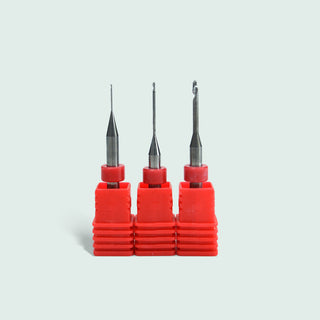The heart of a wet or dry dental milling system is its cutting tool. These precision instruments transform a digital design into a physical restoration, and their selection, use, and maintenance directly affect marginal integrity, surface finish, and laboratory profitability. A strategic approach to milling tools is a direct investment in quality and efficiency.
Anatomy of a Milling Tool: Understanding the Geometry
A milling bur is defined by its:
-
Substrate: Typically solid carbide or, for extreme longevity, diamond-tipped. Carbide provides an excellent balance of toughness and cost-effectiveness.
-
Coating: Special coatings reduce friction and enhance heat transfer, significantly extending tool life, particularly suitable for zirconia materials.
-
Flute Design: The number, shape, and helix angle of the flutes determine chip evacuation, cutting aggression, and final surface finish. More flutes generally produce a finer finish.
Selecting the Right Tool for the Material and Task
There is no universal milling bur. The correct choice is material-specific:
-
Zirconia (Sintered & Pre-sintered): Requires coarse-grit, durable diamond burs or robust carbide burs with strong geometry to withstand the abrasive nature of the material.
-
Wax & PMMA: Standard carbide burs are sufficient. The focus is on sharp, clean cuts for patterns and provisionals.
-
Lithium Silicate Glass-Ceramics : Diamond-impregnated burs are essential for machining this hard, brittle material without causing micro-fractures.
-
Titanium & Cobalt-Chromium: This is the most demanding application, requiring specialized, wear-resistant carbide or diamond-coated tools designed for metal machining.
Best Practices for Maximizing Tool Life and Accuracy
-
Implement a Tool Life Counter: Do not guess. Track the milling hours or number of cycles for each tool and replace them proactively according to the manufacturer's guidelines.
-
Proper Installation & Runout Check: Ensure tools are installed correctly and that spindle runout is minimal. Excessive runout causes uneven wear, poor finish, and premature tool failure.
-
Optimized Milling Strategies: Use the CAM software's recommended strategies—roughing cycles with aggressive tools followed by finishing cycles with fine-grit tools. This preserves the finishing tools for critical surfaces like margins.
Conclusion
Viewing milling tools as consumables is a costly oversight. By treating them as precision instruments and adhering to a disciplined maintenance and selection protocol, laboratories can achieve superior restoration quality, reduce downtime, and control operational costs.

